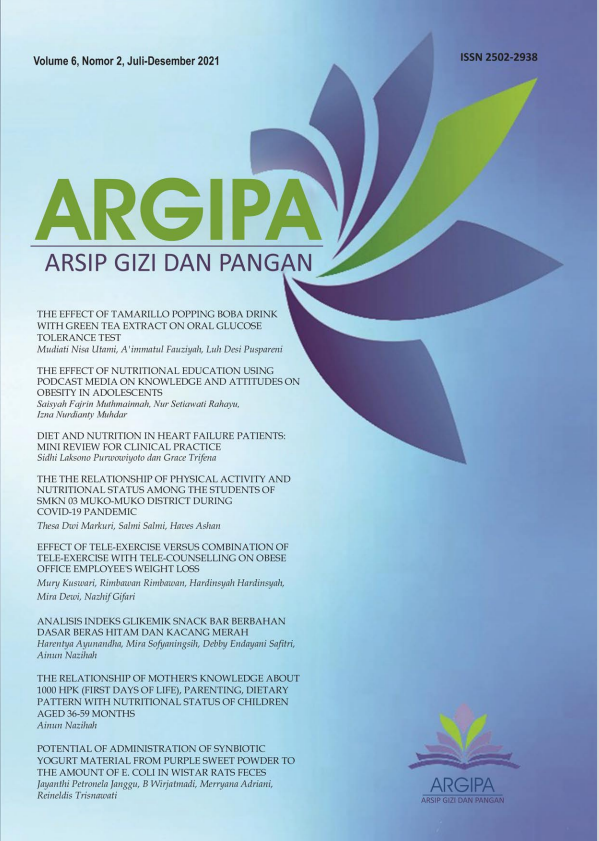Potential of administration of synbiotic yoghurt material from purple sweet powder to the amount of E. coli in wistar rats feces
DOI:
https://doi.org/10.22236/argipa.v6i2.6772Keywords:
Enteropathogenic Escherichia coli (EPEC), Ubi Jalar Ungu, Yogurt SinbiotikAbstract
The number of pathogenic bacteria Escherichia coli which increases in the digestive tract can cause infectious diseases in humans. One of the pathogenic bacteria in the digestive tract, especially the small intestine, which often causes digestive disorders is Enteropathogenic Escherichia coli (EPEC). EPEC bacteria in the digestive tract can damage the intestinal mucosa causing infectious diseases in humans. This study aimed to determine the effect of synbiotic yogurt (made from Lactobacillus bulgaricus, Streptococcus thermophilus, Bifidobacterium bifidum and purple sweet potato juice) on the number of E. coli in mice. A total of 24 male wistar rats were used in this study which consisted of 4 groups, namely (1) negative control, (2) positive control, (3) synbiotic yogurt, (4) synbiotic yogurt + EPEC. Yogurt was given orally using a sonde from day 1 to 21, with a population of lactic acid bacteria 107 CFU / ml. EPEC infection was carried out orally using a sonde from day 8 to 14, with a population of 106 CFU/ml. On the 22nd day, rat feces were collected and the number of bacterial colonies identified as E. coli was carried out on Mac Conkey Agar (MCA) selective media with a Spread Count Method. EPEC infection caused diarrhea, both in the positive control group mice and the synbiotic yogurt + EPEC group. The positive control group of rats had the highest number of E. coli colonies and was significantly different from the other groups of mice. Giving synbiotic yogurt (both in the synbiotic yogurt group and the synbiotic yogurt group + EPEC), significantly decreased the number of E. coli colonies in mice). Synbiotic yogurt can prevent diarrhea.
Downloads
References
Astawan, M., Wresdiyati, T., Arief, I. I., & Suhesti, E. (2011). Gambaran hematologi tikus putih (Rattus norvegicus) yang diinfeksi Escherichia coli enteropatogenik dan diberikan probiotik. Media Peternakan, 34(1), 7–13.
Bintari NWD, Sudarma N, Made N, Ariani MNS. (2018). Cemaran staphylococcus aureus dan bakteri gram negatif pada membran stetoskop di ruang perawatan intensif. Jurnal Undirah Bali. 2018:649–656.
Firmansyah, A., Juffrie, M., Hegar, B., Ranuh, R., & Bakhtiar. 2018. Proceeding Book Simposium dan Workshop dalam tema Update In Diagnosis and Management of Gastroentero-Hepatology and Nutrition Problems in Children. Fakultas Kedokteran Universitas Syiah Kuala : Banda Aceh
Ginting, E., Utomo, J. S., & Yulifianti, R. (2011). Potensi ubi jalar ungu sebagai pangan fungsional. Iptek Tanaman Pangan, 6(1), 116-138.
Imelda, F., Purwandani, L., & Saniah (2020). Total bakteri asam laktat, total asam tertitrasi dan tingkat kesukaan pada yoghurt drink dengan ubi jalar ungu sebagai sumber prebiotik. Jurnal Vokasi, 15(1).
Korengkeng, A. C., Yelnetty, A., Hadju, R., & Tamasoleng, M. (2020). Kualitas fisikokimia dan mikrobia yoghurt sinbiotik yang diberi pati termodifikasi umbi uwi ungu (Dioscorea alata) dengan level berbeda. Zootec, 40(1), 124–133.
Lesmanawati, W., Widanarni, Sukenda, Purbiantoro, W. (2013). Potensi ekstrak oligosakarida ubi jalar sebagai prebiotik bakteri probiotik akuakultur. Jurnal Sains Terapan, 3(1), 16–20.
Lestari, L. A. (2015). Peran Probiotik di Bidang Gizi dan Kesehatan (Junaedi (ed.)). Yogyakarta: Gadjah Mada University Press.
Murtini, S., Nurhayati, T., Purwanto, S. B., Wibawan, I. W. T. 2005. Pengembangan metode produksi antigen protease Escherichia coli Enteropatogenik (EPEC). J Med Vet Indonesia, 9(1), 27-31.
Prasetya, Y. A., Winarsih, I. Y., Pratiwi, K. A., Hartono, M. C., & Rochimah, D. N. (2019). Deteksi fenotipik Escherichia coli penghasil Extended Spectrum Beta-Lactamases (ESBLS) pada sampel makanan di Krian Sidoarjo. Life Science, 8(1), 75–85.
Rizal, S. & Nurainy, F. (2018). Ketahanan terhadap kondisi pH asam dan aktivitas antagonis terhadap bakteri patogen empat jenis bakteri asam laktat. Prosiding Seminar Nasional Pengembangan Teknologi Pertanian SEMNAS Tektan VI, 1–425.
Sayuti, I., Wulandari, S., & Sari, D. K. (2013). Efektivitas penambahan ekstrak ubi jalar ungu (Ipomoea batatas var. Ayamurasaki) dan susu skim terhadap kadar asam laktat dan pH yoghurt jagung manis (Zea mays L. Saccharata) dengan menggunakan inokulum Lactobacillus acidophilus dan Bifidobacterium sp. Biogenesis, 9(2), 21–27.
Tari, A. I. N., Handayani, C. B., & Hartati, S. (2020). Sinbiotik ekstrak ubi ungu dan probiotik lokal pada Yogurt: kesehatan pencernaan, hematologi, dan sistem imun. Journal Agritech, 40(4), 312–321.
Usmiati, S., Miskiyah, & Rarah, R.A.M. (2009). Pengaruh penggunaan bakteriosin dari Lactobacillus sp. Galur SCG 1223 terhadap kualitas mikrobiologi daging sapi segar. JITV, 14(2), 150–166.
Utami, R., Andriani, M. A. M., & Putri, Z. A. (2010). Kinetika fermentasi yoghurt yang diperkaya ubi jalar (Ipomea batatas). Caraka Tani, XXV(1), 51–55.
Videlock, E. J. & Cremonini, F. (2012). Meta-analysis: probiotics in antibiotic-associated diarrhoea. Alimentary Pharmacology and Therapeutics, 35(12): 1355-1369.
Wahyudi, A., Damat, Saati, E. A., Azis, N., & Wachid, M. (2013). Produksi yoghurt sinbiotik. Jurnal Dedikasi, 10 (Mei 2013), 1–6.
Wahyuningsih, R. (2019). Identifikasi adanya bakteri Escherichia coli pada minuman es teh yang dijual di sekitar Stikes BCM Pangkalan Bun wilayah Kotawaringin Barat. Jurnal Borneo Cendekia, 3(1), 15.
Widiyaningsih, E. N. (2011). Peran probiotik untuk kesehatan. Jurnal Kesehatan, 4(1), 14-20.
Wijayanti, M. I., Purwijantiningsih, L. M. E., & Pranata, F. S., (2016). Kualitas yoghurt sinbiotik sari beras hitam (Oryza sativa L.) dengan variasi susu skim. Jurnal Fakultas Teknobiologi, Universitas Atma Jaya Yogyakarta, 1–16.
Yuniastuti, Ari. (2015). Buku Monograf: Probiotik (dalam Perspektif Kesehatan). Semarang: Unnes Press.

















